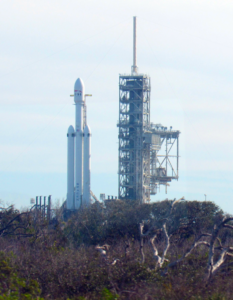
Space Coast launch life isn’t just about rockets and space – in fact, for the past few days, our focus has been fixed on the water.
Yesterday, on a bright sunny Florida winter day, the SpaceX drone ship Just Read The Instructions (JRTI) was brought into Port Canaveral to join sister ship Of Course I Still Love You (OCISLY) for the first time since their shipyard days 4+ years ago.
(Featured Image by @baserunner0723.)
Since their acquisition by SpaceX, these ships have been supporting first-stage landings at sea on opposite sides of the United States – OCISLY on the east coast, JRTI on the west coast. Recently, however, the frequency of west coast launches from Vandenberg AFB has waned, while the cadence on the east coast has increased, due in part to SpaceX’s launches of satellites for their Starlink constellation. Presumably, this is the reason for moving JRTI to Port Canaveral.
For some months, JRTI had been undergoing repairs and/or upgrades in Louisiana – until the day when sharp-eyed onlookers reported that the drone ship was no longer there:
#JRTI is gone!!
"Just Read the Instructions" has left the dock where she has been getting worked on for the last few months!
Since the deck wings were reinstalled, she isn't going through the Panama canal again. That means Brownsville or, more likely, Florida. pic.twitter.com/865odm8QIq
— Daryl Sausse` (@SausseImages) December 8, 2019
Diligent ship trackers soon confirmed that the tug Alice C was towing JRTI toward Port Canaveral, and anticipation grew as we awaited their arrival.
Soooooooo @SausseImages just made my night! #JRTI is no longer at the docks and Tug Alice C is already on the Eastern Coast of Florida with a destination of Port Canaveral. I think we may be getting an extra special delivery very soon! #SpaceXFleet https://t.co/XN4LbhFUC1 pic.twitter.com/G1JV3EkjaE
— Julia (@julia_bergeron) December 9, 2019
Rough estimate if Alice C keeps this pace is actually not much past expected. Maybe 5:00 am ET. Four cruise ships would take priority with last expected at 6:00 am. IF JRTI is in tow it would be after that to use pilot and tug services and closer to daylight. #SpaceXFleet #JRTI pic.twitter.com/YZt8tc0OPN
— Julia (@julia_bergeron) December 9, 2019
By Monday, it was confirmed that Alice C and JRTI were sitting outside the entrance to Port Canaveral. Naturally, the usual Space Coast crew headed to Port – to wait, and hypothesize, and take lots of pictures.
Good morning #SpaceXFleet and B1059.1 The possibilities are endless as the sun rises. Will #JRTI arrive? Will the Sisters get their nets? Will 1059 retract the remaining legs? Will Searcher go out for training ops? Never a dull day around Port Canaveral. pic.twitter.com/CNX7NqsBsz
— Julia (@julia_bergeron) December 9, 2019
Sure looks like #JRTI 1st pic of #AliceC #SpaceX #SpaceXFleet pic.twitter.com/WiRkBGxXJE
— John Winkopp (@John_Winkopp) December 9, 2019
Savvy onlookers like Julia quickly deduced that SpaceX’s two fairing-catcher boats, Ms. Tree and Ms. Chief, would have to relocate to make room for JRTI.
There she is! #JRTI is going to be worth the wait. Tug Florida has arrived for line switch. Mystery and Mischief are about to move north to make room for the new resident to dock at North Cargo Pier 6. #SpaceXFleet @elonmusk pic.twitter.com/l3TkQL6RuZ
— Julia (@julia_bergeron) December 9, 2019
In order to berth JRTI, a dock wedge needed to be installed – essentially, a bumper, to allow the ship to be moored without scraping anything.
It appears the wedge for the dock ran alongside JRTI and is now inbound to the docks with Tug Florida. #SpaceXFleet #JRTI pic.twitter.com/wrSvtvcGwg
— Julia (@julia_bergeron) December 9, 2019
Closeup on the wedge for #JRTI #SpaceXFleet @SpaceXFleet pic.twitter.com/pCAW6HKNGQ
— Jared-Base | Starliner OFT (@baserunner0723) December 9, 2019
While this work was done, Alice C and JRTI waited patiently outside Port Canaveral. Their proximity inspired new speculation, as to what else (besides the dock wedge) they might be bringing.
Tug Alice C is doing a turn. It appears there are a lot of containers on board. I wonder if they are bringing additional supplies or maybe a Christmas present for OCISLY in the form of upgrade equipment. Purely guessing while we wait. #SpaceXFleet #JRTI pic.twitter.com/d3oUwiRh1u
— Julia (@julia_bergeron) December 9, 2019
#JRTI and Alice C appear to be in the channel heading north now #SpaceXFleet @SpaceXFleet pic.twitter.com/okwgvHQ7kI
— Jared-Base | Starliner OFT (@baserunner0723) December 9, 2019
Meanwhile, the booster from CRS-19 – remember the booster? ‘cuz there was a booster – serenely waited for its ride to arrive.
The transporter for the Falcon 9 booster arrived while we were waiting on #JRTI 2/n pic.twitter.com/w2KOKBYWsW
— Jared-Base | Starliner OFT (@baserunner0723) December 9, 2019
Alas, the day’s work could not be completed before the arrival of several scheduled cruise ships (you know, those big fancy boats that don’t haul rockets) and so the ship stalkers had to take their leave of Port Canaveral, and await the next morning – a day which would be free of such issues.
Tuesday dawned bright and sunny, as the ship-stalkers once again assembled in Port Canaveral to keep watch for JRTI:
JRTI morning update:
Alice C is still hanging out at the Port Canaveral Anchorage and traffic chatter is quiet. I suspect the plan is to finish getting the dock ready for her arrival before they call JRTI into port. #SpaceXFleet #JRTI pic.twitter.com/TuqyuJGdFt— Julia (@julia_bergeron) December 10, 2019
Checking in at the port. B1059.1 is still standing. No visible action at the moment. Hoping to see booster rollout and #JRTI arrival today! pic.twitter.com/IGagNs1PgJ
— Stephen Marr (@spacecoast_stve) December 10, 2019
Heck, I even made it down there myself for awhile!
Lovely day to hang out with friends and watch some boats! 😁 pic.twitter.com/U4cHCwG7zJ
— Wayward Plane ✈️ (@WaywardPlane) December 10, 2019
Oh yeah, there's a booster here, too. pic.twitter.com/IAKybYlZ4I
— Wayward Plane ✈️ (@WaywardPlane) December 10, 2019
Logistics and maneuvering proceeded apace, as workers made room for all their kids at the dock.
It appears that #JRTI is waiting to have room at the dock. Work is focused on GO Ms. Chief to finish rigging and move to the north end. The bumper has been placed at the center point of the JRTI space behind OCISLY and there definately is not enough room yet. #SpaceXFleet pic.twitter.com/7vLwNEmsxR
— Julia (@julia_bergeron) December 10, 2019
Tug Florida at #JRTI’s wedge #SpaceXFleet @SpaceXFleet pic.twitter.com/LclUJgn5SH
— Jared-Base | Starliner OFT (@baserunner0723) December 10, 2019
Tug Alice C, #JRTI, and Tug Florida#SpaceXFleet @SpaceXFleet pic.twitter.com/UjkgDH6Nkm
— Jared-Base | Starliner OFT (@baserunner0723) December 10, 2019
Finally, at around 2:30 pm, it happened: JRTI and company made their way into the port!
SpaceX’s “Just Read The Instructions” droneship is approaching Port Canaveral. pic.twitter.com/X5XqnIa5aP
— John Kraus 🚀 (@johnkrausphotos) December 10, 2019
JRTI UPDATE: Tug Alice C brought #JRTI on its long voyage from Louisiana this afternoon arriving in port just after 2:30 this afternoon. The drone ship was packing many supplies for its new missions. #SpaceX #ElonMusk #NASA pic.twitter.com/huvwuku6w5
— Greg Scott 🚀🚢😎 (@GregScott_photo) December 10, 2019
LIVE from @julia_bergeron stream of #JRTI #SpaceXFleet
Look at the size difference between #OCISLY (right) and #JRTI (Left) pic.twitter.com/lawWDXTTr2
— Jon Van Horne 🐴📷🌴 (@therealjonvh) December 10, 2019
Time lapse: SpaceX’s Just Read The Instructions droneship docks at Port Canaveral. pic.twitter.com/tVEq4Nj0bd
— John Kraus 🚀 (@johnkrausphotos) December 10, 2019
Just Read The Instructions has been birthed next to sister ship, Of Course I Still Love You. I’m pretty sure this is the first time the two droneships have been side by side. Meanwhile, work continues on booster B1059. What a day! pic.twitter.com/GxyOlHzaNO
— Stephen Marr (@spacecoast_stve) December 10, 2019
Upon entry into the Port, onlookers were finally able to catch a glimpse of that cargo JRTI was carrying: among other things, six thrusters, to help JRTI (or perhaps OCISLY) with their booster-catching shenanigans.
There were six thrusters on deck along with the engine containers. These are powerful upgrades that should help with some of the rough Atlantic missions. #SpaceXFleet #JRTI pic.twitter.com/gdxavvm8Fj
— Julia (@julia_bergeron) December 10, 2019
#JRTI had 6 engines on it's deck. They are huge. Person for scale in the third photo. #SpaceXFleet @SpaceXFleet pic.twitter.com/aA4przvPqr
— Jared-Base | Starliner OFT (@baserunner0723) December 10, 2019
I bet you wish you could’ve been there, huh? Fortunately, Julia was gracious enough to stream the arrival, and so you can relive those moments from the comfort of your easy chair, and without having to spend two days in the sun to do it:
Just Read the Instructions is about to enter Port Canaveral. Enjoy the view with me! #SpaceXFleet #SpaceX #JRTI https://t.co/Y1EyY21GL4
— Julia (@julia_bergeron) December 10, 2019
Whether it’s at the space port, or the ship port, or out on the beaches, launch life on the Space Coast is always an adventure!

